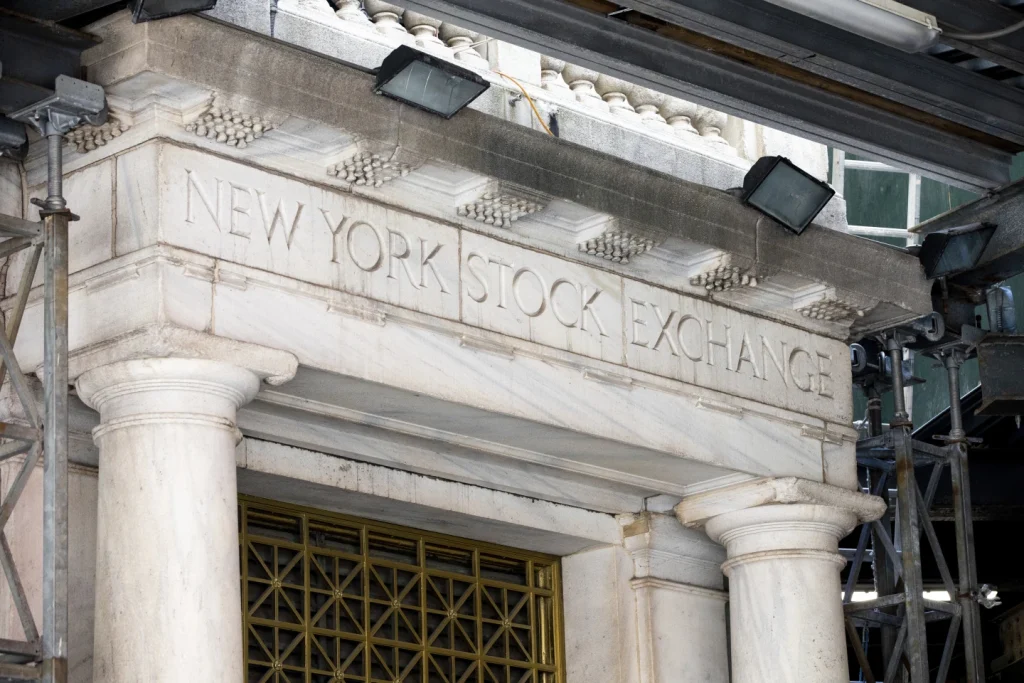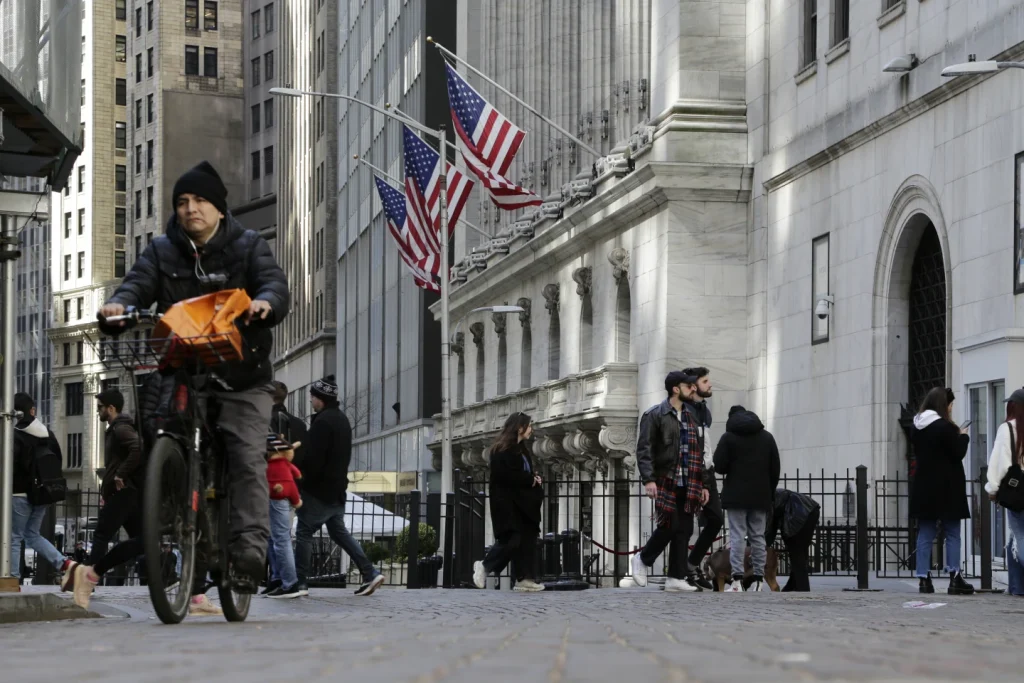The year 2023 marked a period of significant financial resurgence and transformation, as exemplified by the impressive performance of the S&P 500 and Dow Jones Industrial Average.
The closing statistics for the year reflect a remarkable gain of over 24% for the S&P 500, while the Dow finished near a record high, showcasing the enduring strength of the economy and the optimism of investors.
This essay aims to delve into the various factors that contributed to this exceptional year in the stock market, including the impact of easing inflation, the resilience of the economy, and the prospect of lower interest rates.
Furthermore, it will explore the influence of key companies, such as the “Magnificent 7,” and the broader implications of their performance on the market.
The S&P 500’s closure with a rare ninth consecutive week of gains is a testament to the sustained momentum that characterized the latter part of the year.
Despite modest losses on the final day of trading, the index remained within striking distance of its all-time high, set in January of 2022.

Similarly, the Dow Jones Industrial Average, after reaching a record high the previous day, closed out the year with a slight decline, emphasizing the overall robustness of the market.
The Nasdaq also experienced a minor setback in its closing numbers, yet this was overshadowed by an annual gain of over 43%, marking its best performance since 2020.
Throughout the year, the market’s upward trajectory was largely propelled by the exceptional performance of seven prominent stocks, aptly named the “Magnificent 7.”
These companies, including Apple, Microsoft, Alphabet, Amazon, Nvidia, Meta Platforms, and Tesla, played a pivotal role in driving approximately two-thirds of the gains in the S&P 500.
Notably, Nvidia emerged as the leader within this group, with an astounding gain of about 239%, fueled by the fervor surrounding artificial intelligence.
This concentration of influence within a select group of companies underscores the evolving dynamics of the market and the profound impact of technological advancements on investment trends.
A notable turning point in the year’s market activity occurred during the strong rally witnessed in November and December.
This surge represented a significant psychological shift for investors, as it extended beyond the dominance of the major technology companies.
The Russell 2000 index, which tracks smaller companies, surged by over 20% in the final two months of the year, culminating in a 15.1% gain for 2023.
This remarkable recovery marked a stark contrast to the previous year, during which the index experienced a substantial decline of 21.6%.
The resurgence of smaller companies not only reflects the broad-based optimism that permeated the market but also signifies a renewed confidence in the potential of diverse sectors to drive sustained growth.
Quincy Krosby, chief global strategist at LPL Financial, aptly characterized the late-year rally as a significant psychological shift for investors.
The expansion of market gains beyond the domain of major technology firms underscores the diversification of investment opportunities and the emergence of new sources of value.
This shift is indicative of a broader transformation within the market, signifying a departure from the overreliance on a select group of companies towards a more inclusive and dynamic investment landscape.
In conclusion, the year 2023 was defined by a remarkable display of resilience and transformation within the stock market.

The exceptional performance of key indices, the influence of the “Magnificent 7,” and the resurgence of smaller companies collectively underscore the evolving dynamics of the market and the enduring optimism of investors.
The year’s closing statistics not only reflect a period of financial resurgence but also signify a broader shift in investment patterns and the emergence of new sources of value.
As we embark on a new year, the lessons and insights gleaned from the events of 2023 will undoubtedly shape the trajectory of the market and inform investment strategies for the future.
The year 2024 has dawned upon the financial landscape with a sense of cautious optimism and calculated anticipation.
The preceding year, 2023, was marked by a series of economic challenges, including sharp losses in both stocks and bonds, leading investors to brace themselves for potential headwinds.
However, amidst these concerns, the market has exhibited resilience, propelled by various factors such as consumer spending, job market stability, and evolving Federal Reserve policies.
This essay will delve into the intricate interplay of market dynamics, investor sentiments, and the anticipated impact of Federal Reserve decisions on the economic landscape in 2024.
The resilience of the market in the face of prior adversities has been a notable phenomenon. According to Krosby, broad participation in the market has reinforced and confirmed gains for smaller company stocks, underscoring their pivotal role in bolstering market stability.
This underscores the significance of diverse market participation in sustaining and amplifying positive outcomes, thereby contributing to the overall health of the financial ecosystem
The specter of inflation has loomed large in the minds of investors, with expectations of its gradual alleviation as the Federal Reserve embarked on a trajectory of raising interest rates.
The anticipated trade-off between curbing inflation and the potential dampening of economic growth has been a subject of intense scrutiny.
While inflation has subsided to approximately 3%, the economy has exhibited resilience, buoyed by robust consumer spending and a robust job market.
This unexpected vigor has led to a reevaluation of the potential trajectory of the economy, with the notion of a “soft landing” gaining traction.
The concept of a “soft landing” entails a delicate equilibrium where the economy moderates sufficiently to quell inflationary pressures without plunging into a recession.
The Federal Reserve’s pivotal role in shaping market expectations and economic trajectories cannot be overstated.

The central bank’s signaling of three quarter-point cuts to its benchmark interest rate in the upcoming year has reverberated throughout financial markets.
With the current benchmark rate hovering between 5.25% and 5.50%, its highest level in two decades, the prospect of lower rates on the horizon has ignited speculation and recalibration of investment strategies.
The market’s anticipation of the Fed’s potential rate cuts as early as March has injected a new dimension of dynamism into investment decision-making.
The projected impact of lower interest rates on the broader market’s momentum in 2024 is a subject of keen interest.
Wall Street’s forecasts of enhanced earnings growth for companies in the upcoming year, following a relatively lackluster 2023, reflect the evolving landscape shaped by changing input costs, labor dynamics, and consumer spending patterns.
The potential tailwinds generated by lower interest rates are poised to influence the trajectory of corporate performance and market dynamics in the coming year
As the financial markets navigate the complexities of 2024, the confluence of factors such as inflation, interest rates, and Federal Reserve policies will continue to shape investor sentiments and market dynamics.
The evolving landscape underscores the intricate interplay between economic indicators, investor expectations, and policy decisions, underscoring the need for a nuanced understanding of these dynamics.
The year ahead promises to be a period of recalibration, adaptation, and strategic maneuvering as market participants navigate the terrain shaped by evolving economic forces and policy shifts.
In conclusion, the year 2024 is poised to be a pivotal chapter in the annals of financial markets, characterized by resilience, recalibration, and the enduring quest for equilibrium amidst a backdrop of evolving economic dynamics and policy imperatives.
The year 2023 has been a tumultuous one for bond market investors, with the possibility of a third consecutive year of losses looming large.
However, a significant turnaround occurred in late October, driven by the anticipation of potential cuts to interest rates.
This led to a remarkable surge in bond prices and a subsequent decline in yields. Notably, the yield on the 10-year Treasury, which had reached 5% in October, stood at 3.88% on a Friday, marking a notable increase from the 3.85% recorded on the preceding Thursday.
Simultaneously, the yield on the two-year Treasury, which closely mirrors expectations for the Federal Reserve, experienced a decrease from 4.28% to 4.25% late on Thursday.
This yield had also exceeded 5% in October. The global markets also witnessed substantial gains, with France and Germany’s indexes making double-digit advances, and Britain’s index climbing just under 4%.
In the context of global markets, Tokyo’s Nikkei 225 experienced a remarkable 27% gain in 2023, marking its most successful year in a decade.
This surge was attributed to the Japanese central bank’s gradual movement towards ending its long-standing ultra-lax monetary policy, following inflation finally surpassing its target of approximately 2%.
Conversely, the Shanghai Composite index incurred a 3% loss over the year, while the Hang Seng index in Hong Kong fell by nearly 14%.
The downturn in these markets was influenced by weaknesses in the property sector, diminished global demand for China’s exports, high debt levels, and wavering consumer confidence, collectively exerting pressure on the country’s economy and stock market.
The stability of U.S. and international crude oil prices on a Friday was noteworthy, especially considering the overall trend of the year.
Despite predictions from some experts that oil prices could surpass $100 per barrel, the price of oil plummeted by over 10% in 2023.
This decline was particularly striking, given the backdrop of production cuts from the Organization of the Petroleum Exporting Countries (OPEC) and ongoing conflicts involving energy exporter Russia and the Middle East.
The U.S., now the leading oil producer globally, along with increased production from Canada, Brazil, and Guyana, effectively offset the reduced output from OPEC.
Notably, not all OPEC members adhered to the production cuts, and countries such as Iran and Venezuela increased their oil production, as indicated by energy analysts.

In conclusion, the events and fluctuations observed in the bond market, global stock markets, and the oil industry in 2023 are indicative of the complex and interconnected nature of the global economy.
The intricate interplay of factors such as interest rates, central bank policies, geopolitical tensions, and production dynamics have collectively shaped the financial landscape, underscoring the need for astute analysis and strategic decision-making in navigating the ever-evolving world of investment and finance.
This essay delves into the intricate details of the financial landscape in 2023, shedding light on the dynamics that have influenced bond markets, global stock markets, and the oil industry.
The interplay of factors such as interest rates, central bank policies, geopolitical tensions, and production dynamics has shaped the financial landscape, underscoring the need for astute analysis and strategic decision-making in navigating the ever-evolving world of investment and finance.
